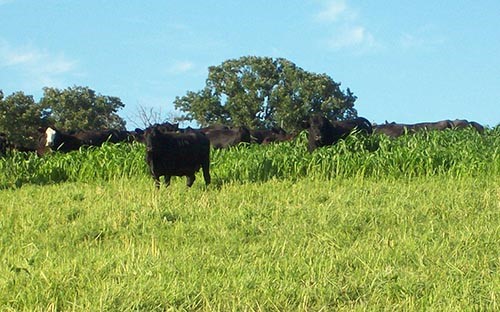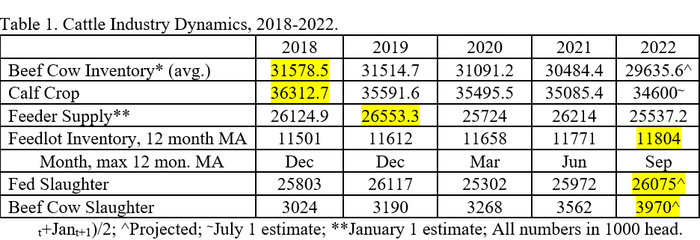Cattle industry dynamics finally lining up
It's official: The United States has a tight cattle supply now.

The latest Cattle on Feed report pegs November 1 feedlot inventory at 11.706 million head, 98.0 percent of last year and the second consecutive monthly year over year decrease. The 12-month moving average of feedlot totals, which shows the average feedlot total for the previous year, peaked in September 2022 (Table 1). Feedlot inventories are expected to decrease year over year for the foreseeable future. Table 1 shows how cattle industry dynamics have developed since the last cyclical peak, with peak totals for each category highlighted in yellow. The peak average cow herd and calf crop occurred in 2018 with the peak feeder supply noted on January 1, 2019.

The combination of effects from the pandemic in 2020 and drought since 2020 has pushed the peak in feedlot numbers and cattle slaughter into 2022, well past the cyclical peak in the calf crop in 2018. The pandemic in 2020 caused a backlog of cattle in feedlots and in the country. As a result, the estimated feeder supply on January 1, 2021 was higher than 2020. The drought in 2021 and 2020 caused cattle to be marketed earlier than usual and resulted in reduced heifer retention and increased heifer and cow slaughter in 2021 and 2022. Early marketing of cattle, reduced heifer retention and herd liquidation have kept feedlot inventories higher in 2022 and temporarily increased beef production. Beef production is projected at a record large 28.4 billion pounds in 2022 as a result of the highest total cattle slaughter in 15 to 20 years.
As 2022 comes to a close, it appears that feedlot inventories have peaked and cattle slaughter should begin to decline in the next few months. On October 1, 2022, the inventory of heifers in feedlots was higher than the previous year, with the heifer percentage of total feedlot inventories the highest in 21 years. The number of heifers in feedlots should begin to decline and will drop sharply when herd rebuilding begins. Feedlot inventories are beginning to reflect the fact that feeder cattle supplies have been declining since 2019.
With drought conditions continuing, it is unclear when herd liquidation will cease and herd rebuilding can begin. However, it is clear that feedlot production, cattle slaughter beef production will fall in 2023. How much they will fall depends on when drought conditions will improve. Nevertheless, declining feedlot supplies mean that all levels of the cattle are finally on the same page and are reflecting the tighter cattle supplies in the country.
Source: Oklahoma State University
About the Author(s)
You May Also Like



